Where Arts & Science Meet
All across Cal Poly Humboldt, these fields of study converge through rich, interdisciplinary experiences inside classrooms and beyond.
by Melissa Hutsell
KEN BALLINGER is an engineer at the U.S. Mint, where he maintains, designs and builds machines. So, it may come as a surprise that his journey has roots in music at Cal Poly Humboldt.
For Ballinger—who pursued a degree in mechanical engineering at Sacramento State University after completing a music degree at Cal Poly Humboldt in 1999—it’s not hard to see how music and engineering intersect.
“My observation is that my brain handles mathematics and formulas similarly to musical patterns, permutations, and compound thinking,” he says. “I think this helped me with my math and engineering classes. Engineers have to be creative, not just technical, to arrive at good solutions. And teamwork, listening, and humility, as with writing and performing music, are still very important.”
Ballinger’s career path represents the importance of the arts and the University's strength in arts and science programs.
Research from the Brookings Institute and others shows that arts education improves student motivation and engagement, creativity, empathy, communication and critical-thinking as well as leadership skills. These are among the top skills that employers look for in candidates, according to platforms like LinkedIn and Indeed.
The intersection of arts and science proves not just that there’s a science to art and an art to science. These fields of study are foundational to developing cultural competency and critical thinking and problem-solving skills.
As the University enters into its polytechnic era, both are also integral to its purpose to prepare students to solve the world’s environmental and social challenges.
“When we sought the polytechnic designation, we were purposeful in centering our polytechnic identity on the principles of interdisciplinarity and leveraging our strong foundation in liberal arts, acknowledging that our best graduates exude elements of scientific inquiry, creativity, innovation, and collaboration, which come from students' engagement in arts and sciences,” says Jenn Capps, provost and vice president for Academic Affairs.
All over campus, these fields holistically converge in classrooms and field experiences through interdisciplinary projects that contribute to society.
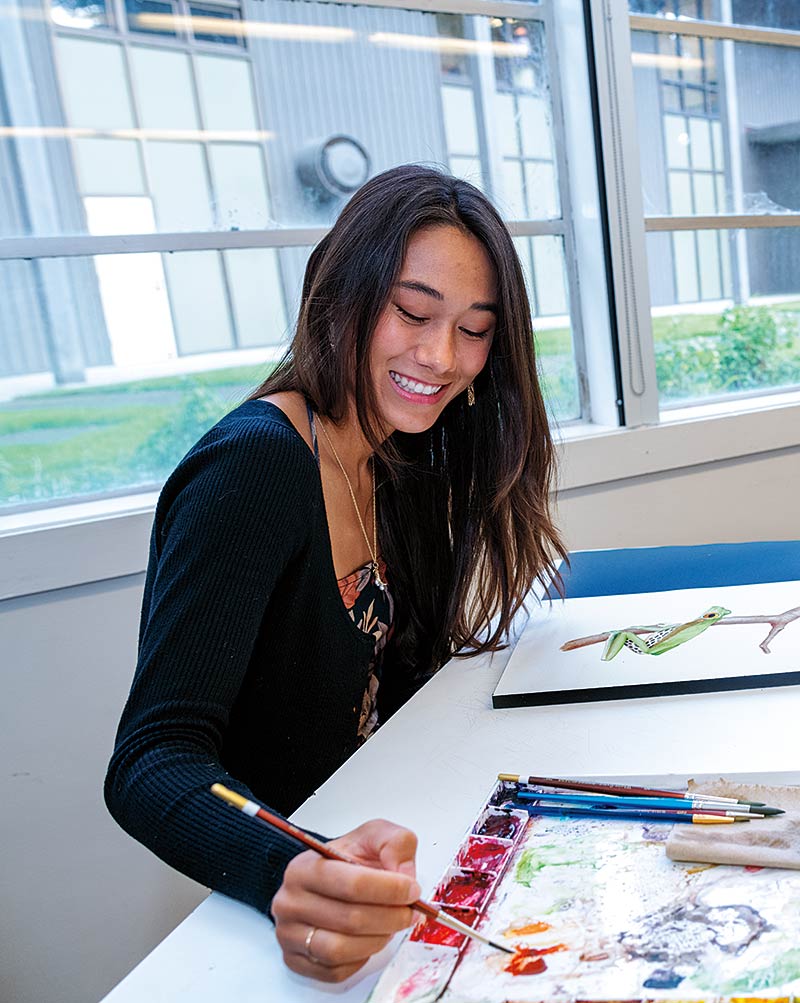
Each week, Scientific Illustration intern Jamie Hefley attended an Illustration course where she interacted with art students. Hefley’s work included drawing the Campo Grande tree frog, which was last observed in 1963 in the State of São Paulo, Brazil. It’s one of two species of frogs formally declared to be extinct in Brazil.
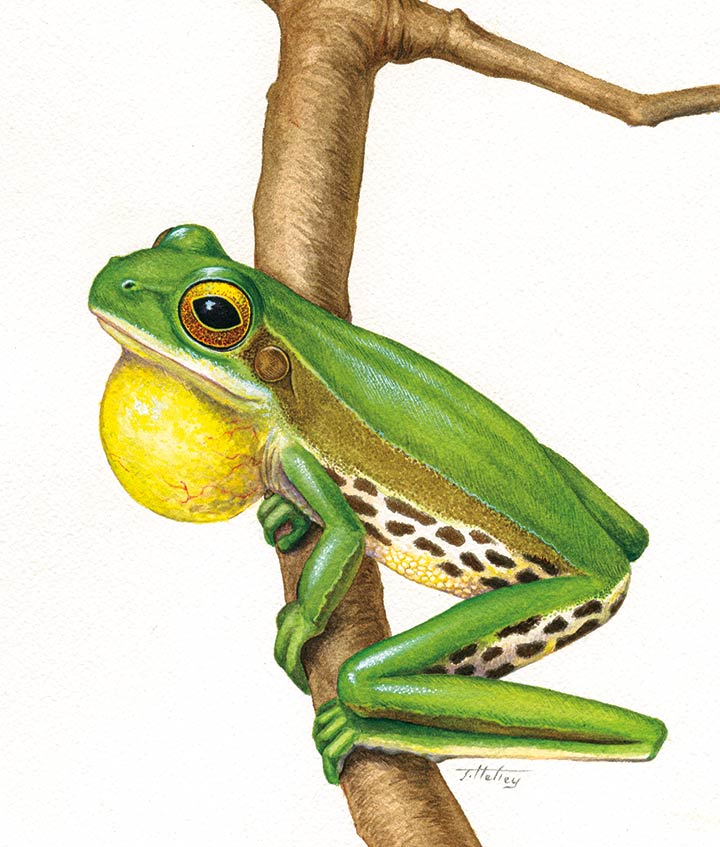
For hundreds of years, scientific inquiry has taken viewers to the unobservable—from the contents of cells and the universe to extinct species
To enhance knowledge of the natural world, Cal Poly Humboldt launched its scientific illustration internship in Fall 2023, a collaboration between professors Pedro Peloso (Biological Sciences) and Brandice Gonzalez-Guerra (Art + Film).
The competitive internship is part of a groundbreaking project by Peloso that aims to raise awareness about the nearly 200 amphibian species at risk of disappearing forever.
He and Gonzalez-Guerra work with interns to bring the extinct species back to life by creating portraits of them.
There are little to no known photos of some of the animals being illustrated, which requires deep dives into scientific literature and museum archives—a process that further emphasizes the importance of such images.
Art is a powerful tool, says the University’s first scientific illustration intern Jamie Hefley. “Through art, we can inspire a greater appreciation and understanding of the natural world and, in turn, encourage efforts to protect and conserve it.”
As part of the program, Hefley works with students in Gonzalez-Guerra’s Illustration I course, allowing for organic interactions with students while they are working on their own illustrations
“With the polytechnic transformation, we felt that this would be a good way to bridge those courses of study and provide students with the opportunity to interact with a professional scientific illustrator and witness the collaborative process that goes into creating a series of scientific illustrations,” Gonzalez-Guerra says.
The internship is not the only opportunity of its type available on campus. Students can take Scientific Drawing I, a popular course on campus among science and art majors in which students create natural history drawings, Gonzalez-Guerra explains. The University's Natural History Museum also offers similar courses to campus and community members.
Art is a powerful tool for scientists to relay information, explains Oscar Vargas, Biological Sciences professor. Vargas’ Plant Taxonomy students create plant journals with drawings of various flora. In fact, nearly all Botany labs require students to illustrate.
“We require students to make art because you learn a lot when you make art,” says Vargas. For example, it helps students memorize plant features and more.
Knowing how to visually present scientific information is an important outreach and communication tool, Vargas explains. “It just makes the understanding of science so much better because language is limited.”
Creative skills can be especially valuable for scientists. “When a scientist is thinking about a new project, there is a lot of creativity that comes into this,” says Vargas. “When we publish our papers, they have illustrations; these illustrations are the easiest way for readers to understand the science.”
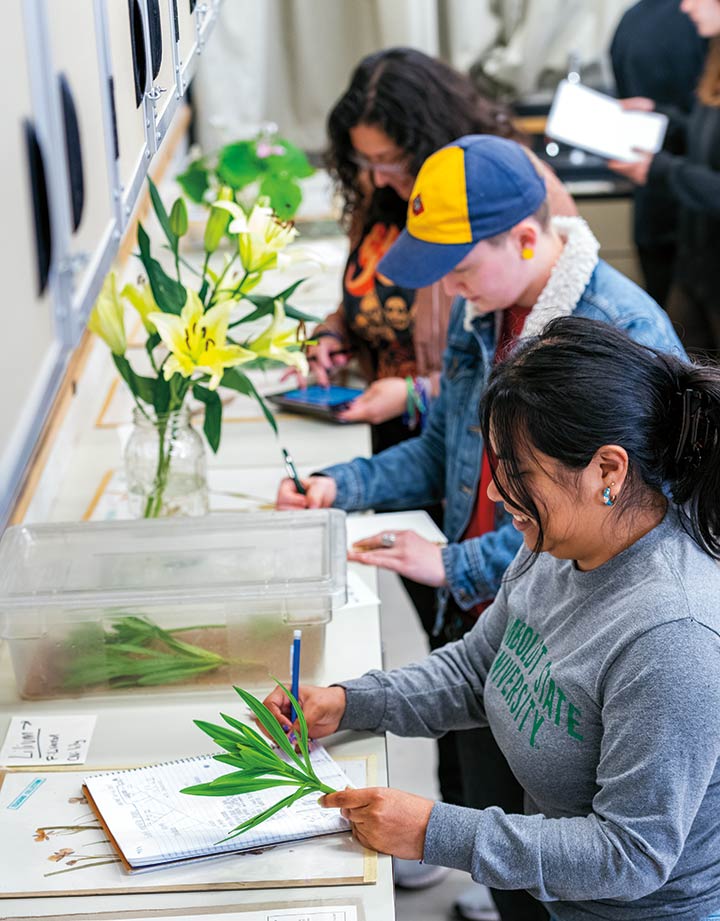
For their Plant Taxonomy course, students draw various flora in their plant journals
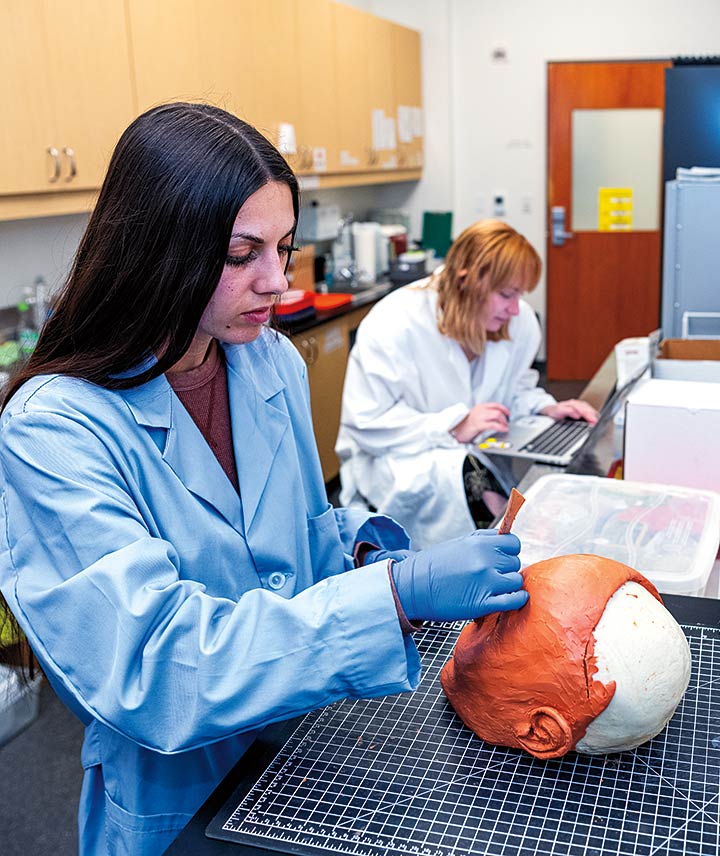
Students Carrie White (foreground) and Joella Holmes in the University’s Biological Anthropology Research Center learn 3D facial reconstruction methods, which can sometimes be used to help identify human remains or give a glimpse into the past.
In the University’s Biological Anthropology Research Center, students practice the science and art of forensic 3D facial reconstruction.
Facial reconstruction generates images of an individual’s face based on their skull features. It can recreate images of Neanderthals, mummies, or modern-day unidentified remains.
The process requires extensive knowledge of facial anatomy, scientific methods, and artistic skills to sculpt a final product with likeness to life.
Using replicas of human skulls, students in the center’s 3D Facial Reconstruction lab apply these methods to reimagine faces of those who have passed. “The skulls we work with are casts from some very special people who chose to donate their body to science,” explains Carrie White, Biology major and lab intern.
Nearly a decade ago, White’s uncle went missing. “As someone who has experienced what it feels like to have a family member go missing, I hope that my skills gained from this project can allow me to work on unidentified missing persons cases in the future and potentially reunite someone who is lost with their family,” she says.
White and fellow interns use clay and computerized modeling to reconstruct faces. They begin by estimating the age and sex of the individual whose skull they are working with before placing tissue depth markers on specific points throughout it, covering them with clay. They then add features and digitally refine them using 3D facial modeling software. Some features, like lips or eyes, cannot be deduced from the skull; this is one aspect of the process that requires artistic interpretation.
Alum and former intern Arleen Gomez (‘23, Anthropology, Criminology & Justice Studies) says a fine art background proved useful during this process. “Taking sculpting classes and painting and even drawing helped with the complex facial anatomy.”
The lab attracts students from liberal arts and STEM disciplines including anthropology and biology, providing useful skills for careers in medicine, law, education, and more.
“With its thoughtful design inside and out, the Engineering & Technology Building will reflect who we are—a polytechnic university where all majors across disciplines can learn from each other.”
Michael Fisher,
Associate Vice President for Facilities Management
In some cases, multiple disciplines can be nurtured by a physical space. That’s the inspiration behind two new makerspaces where students have the room and the tools to explore their passions.
The makerspaces, which opened in Fall 2023 and are currently located in the Forestry and Natural Resources buildings, are furnished with custom workbenches and tools, including 3D printers, soldering stations, table saws, sand blasters, textiles stations, a desktop lathe and mill, and more.
Designed to foster interaction across disciplines, they are intended to serve the campus at large. For example, students can utilize the metal shop to produce parts for a robot or a metal frame for a clay sculpture.
So far, they have created 3D-printed signs, an innovative battery-management system, aprons, professional personal protective equipment, and a magnetic tug-of-war prototype game.
The spaces will eventually converge into one makerspace in the University’s new Engineering & Technology Building, which will open in 2026.
“The look and feel of a University can be found through its architecture,” says Michael Fisher, associate vice president for Facilities Management. “With its thoughtful design inside and out, the Engineering & Technology Building will reflect who we are—a polytechnic university where all majors across disciplines can learn from each other.”

The makerspaces in the Natural Resources Building

The makerspaces in the Forestry Building
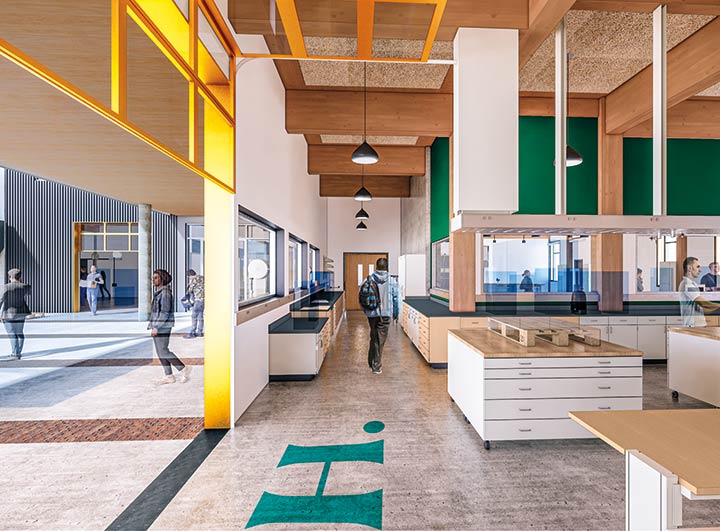
Rendering of new Engineering & Technology Building
Meanwhile, students and graduates are looking through many lenses to better understand the world around us, exploring solutions to real-world challenges.
In the rugged mountain ranges of Northern California, a group of students and faculty in the College of Arts, Humanities & Social Sciences and the College of Natural Resources & Sciences are surveying more than 1,600 locations in an effort to learn more about the plant biodiversity in the Klamath Mountains. The range spans 19,000 square miles from Northern California to Southern Oregon.
“The Klamath Mountains are home to more than 3,500 vascular plant taxa, making it one of the most botanically diverse places in North America,” says Forestry Professor Lucy Kerhoulas (‘06, Botany, ‘08, M.S. Biological Sciences), who co-leads the study with other University faculty including Professor Rosemary Sherriff of the Geography, Environment & Spatial Analysis department and Biology Professor Erik Jules. They are also working alongside the California Native Plant Society on the project.
Through this multidisciplinary effort, they will produce maps that will help with restoration and preservation efforts. It will also promote an understanding of how plant communities are affected by climate change and how vegetation regenerates after fire.
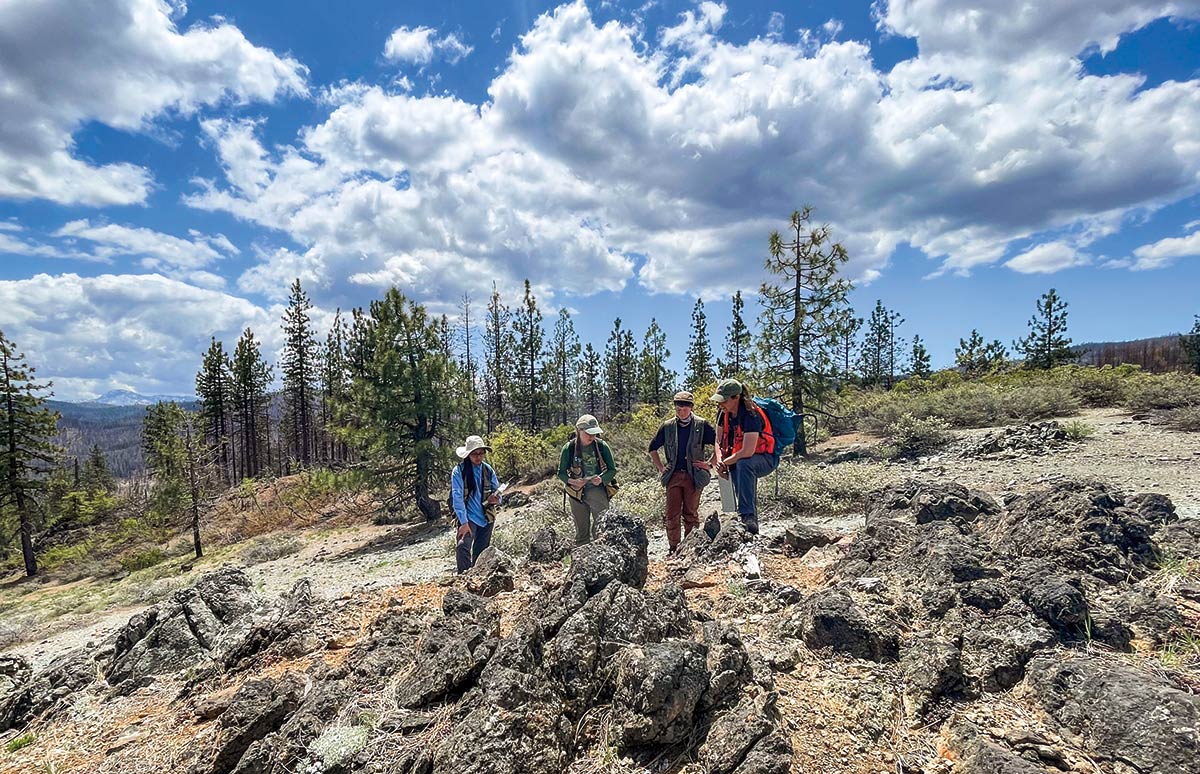
Graduate student Rosa Cox and Professor O’Dowd at one of their sampling sites at Iron Gate Dam.

Dominic Corva (right), Sociology professor and Cannabis Studies program director, leads a discussion for a podcast project.
Cal Poly Humboldt’s newest degree programs further emphasize the University’s strengths in arts and science courses to prepare students for the 21st-century workforce.
Among the first B.A. programs of its type and launched in Fall 2023, the Cannabis Studies degree explores the historical, geographical, cultural, economic, and political contexts of cannabis legalization.
With a focus on social and environmental responsibility, it draws on curriculum from 18 disciplines.
Students must take both liberal arts and STEM classes, explains Dominic Corva, Sociology professor and Cannabis Studies program director. That’s because they must understand things about chemistry to regulate cannabis; they must learn to make maps if they go into public health.
“We're drawing on all these other applied sciences, including in the natural sciences, to give them tools they need,” Corva says, “Some of them will go into science fields like hydrology. Some will become lawyers. Others will go into nonprofit grant writing or community organizing.”
The need for cannabis professionals has grown as more states welcome legal markets and as federal legalization looms. Currently, there are more than 417,000 full-time jobs in the legal cannabis industry with hundreds more added each day, according to job reports. Program graduates are prepared to fill roles including regulators, policy makers, chemists and more.
“Some of them will go into science fields like hydrology. Some will become lawyers. Others will go into nonprofit grant writing or community organizing.”
Dominic Corva,
Sociology professor and Cannabis Studies program director
Kaid Chapman, Cannabis Studies major, does not think he would get this education anywhere else.
“Humboldt is a magical place. There are other Cannabis Studies programs out there, but nothing like what Cal Poly Humboldt offers.”
Chapman’s interest in medicinal cannabis drew him to the program. “Cannabis Studies is perfect because not only do I get to learn about plant science, I also learn about social equity, social justice, and the political and economic part of cannabis.
“The program is helping lay the foundation for a future cannabis industry that we hope to build,” he says. “We're going to make history.”
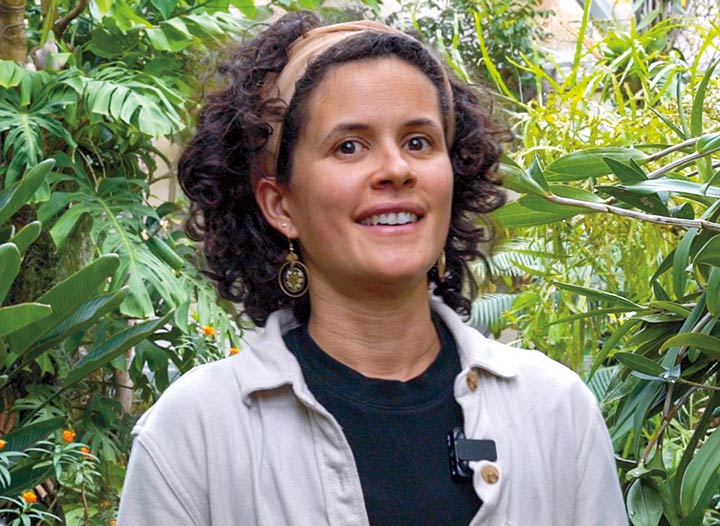
Aubrey Sabre, a student in the Individualized Degree Program, is fusing her passions for fine art, plants, and community organizing into a career in community event planning and sustainable living practices.
The University’s Individualized Degree Program (IDP) also allows students to combine coursework from different disciplines to meet the demands of the 21st-century workforce.
The IDP allows students to design their own degree around their own interests. If a student is interested in illustration and computer science, for example, they can unify that into a degree in video game design.
The possibilities are endless, says program director Rebecca Robertson. “As they explore and bridge gaps between fields, they develop the ability to synthesize ideas, tackle complex problems, and communicate effectively across differences.”
Such interdisciplinary skills provide career flexibility while preparing graduates for jobs in emerging industries like renewable energy, user experience research, or sustainable design. Hannah Kolkmann is combining her passions for healthcare and gender studies. Her IDP degree plan encompasses courses in health education, psychology, and women's studies—topics that spark her interest and make her want to learn.
Kolkmann hopes to be a doctor or nurse, and knowledge in these different fields will allow her to have more holistic interactions with her future patients.
“One needs to look at the entire person when providing medical care. Intertwining health sciences and psychology will provide me with tools to better acknowledge the entire person,” she adds. “Incorporating women's and gender studies will allow me to better address each patient's unique experiences and provide them with the care they need and deserve.”
For Aubrey Sabre, the IDP is liberating and creative. Pursuing it allows her to better care for herself and, in turn, her community. Sabre is fusing her passions for fine art, plants, and community organizing into a career in community event planning and sustainable-living practices. Her current pathway will include courses in business, botany, and art, she says.
Although these are traditionally seen as different fields, Sabre considers them symbiotic. “You cannot have one without the other.” A passion for both the arts and sciences, and the ability to create a career at their intersection, is something that Humboldt alumni do well.

“My pragmatic side had been saying, ‘Well, you better learn something practical.’ So I decided to shift gears and pursue both science and art,” said the late Stephen Hillenburg (‘84, Natural Resources Planning & Interpretation), creator of SpongeBob SquarePants.
Perhaps the most famous example is the late Stephen Hillenburg ('84, Natural Resources Planning & Interpretation), whose passion for marine science and art converged in the animated character SpongeBob SquarePants. Hillenburg originally created the TV program to engage young marine biology students. It is now one of the longest-running, highest-grossing children’s TV programs.
Every day, Humboldt alumni are finding innovative ways to engage youth and impact future generations.
Julie Geary’s (‘11, Biological Sciences) goal as an educator is to nurture an appreciation for nature and give her students the tools to be critical thinkers, good communicators, and problem solvers.
With a background as a dancer and choreographer, Geary was in the premed program at Humboldt. Now she’s a science, technology, engineering, arts, and mathematics (STEAM) teacher at Mead Valley Elementary School in Perris, California, where she serves 4-11 year olds. She wants to make learning fun and squash misconceptions that these subjects are too hard.
She creates arts-integrated lessons that deepen the understanding of the classroom curricula. “I have the best job,” she says. “I get to infuse art, science, and engineering into hands-on lessons and activities for students.”
Geary’s students learn to analyze oil paintings and use rulers and math to understand scale, proportion, and perspective to make art more realistic. These observational skills deepen comprehension and understanding and allow students to think about details in their work, she explains.
“Artists and scientists make careful observations about the world and try to communicate their ideas to others,” Geary adds. “The more opportunities children have to explore ideas through art and science, the greater and deeper their understanding of the natural world is.”
Incorporating science and art is one of the greatest aspects of her job. “They seem like polar opposite ways of looking at and understanding the world, but they really complement each other,” she says.
Geary fondly reflects on her time at Humboldt. “Humboldt is a special place that cultivates and inspires people who are passionate for both scientific and artistic exploration,” she explains. “My science and art professors encouraged me to be creative, a critical thinker, and a keen observer of the natural world. Through both art and science, I was able to explore questions and ideas as well as solve complicated problems in novel and creative ways.”
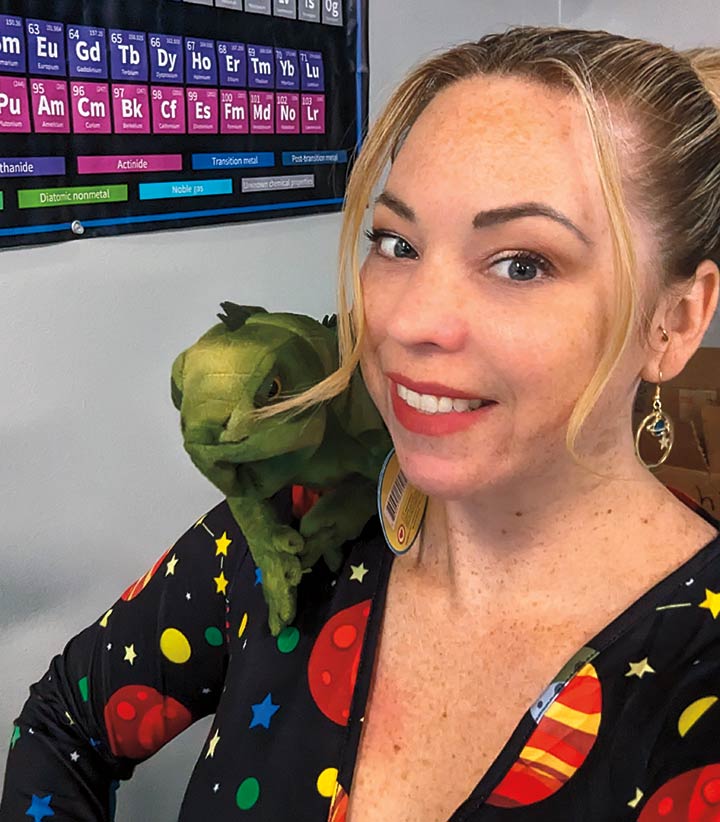
Julie Geary (‘11, Biological Sciences) was in the premed program at Humboldt. Now, she’s a science, technology, engineering, arts, and mathematics (STEAM) teacher at Mead Valley Elementary School in Perris, California.